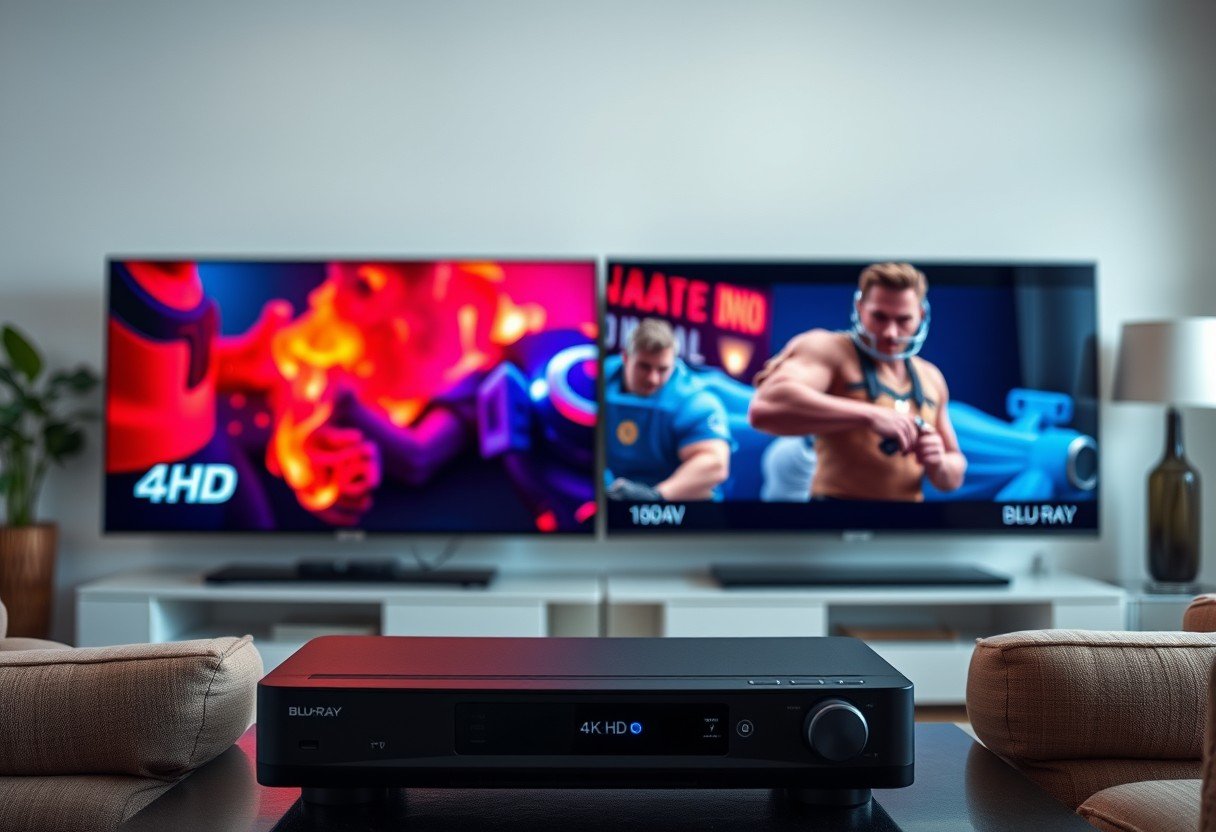Choosing between 4K Ultra HD and standard Blu-ray for your movie collection can be confusing. Both formats offer a high-quality viewing experience, but key differences in resolution, color, and sound can significantly impact how you enjoy your favorite films. This guide breaks down everything you need to know, helping you decide which format is the right investment for your home entertainment setup and cinematic preferences.
What Is the Big Deal with 4K Resolution?
To understand the leap in quality, you first need to grasp what 4K technology is. Also known as Ultra High Definition (UHD), 4K refers to a display resolution of 3840 x 2160 pixels.
This is a massive jump from other formats. 4K offers four times the resolution of standard 1080p HD, which is the resolution provided by standard Blu-ray discs. This huge increase in pixel density results in images that are incredibly sharp, clear, and packed with fine detail.
The benefits are most noticeable on larger television screens. With 4K, you can see intricate textures in clothing, subtle details in landscapes, and a greater sense of depth that makes the picture feel more realistic and immersive. Whether you are watching a blockbuster movie or a nature documentary, 4K brings the visuals to life in a way that was previously only possible in a movie theater.
Understanding the Blu-ray Standard
The Blu-ray experience remains a fantastic option for high-definition viewing and has long been the gold standard for physical media. Blu-ray discs use a blue-violet laser to read data, which allows them to store significantly more information than older DVDs.
This increased storage capacity is what enables Blu-ray to deliver a Full HD resolution of 1920 x 1080 pixels. For years, this provided the sharpest and most detailed picture available for home viewing, creating a true cinematic feel.
Beyond just picture quality, Blu-ray also excels in audio. It supports lossless audio formats like DTS-HD Master Audio and Dolby TrueHD, ensuring that the sound you hear is exactly as the studio engineers intended. Many discs also come packed with bonus content, such as behind-the-scenes featurettes and director’s commentary, offering a complete entertainment package.
Visual Quality: a Side-by-Side Comparison
While resolution is a major factor, the visual differences between 4K and Blu-ray go much deeper. The overall picture quality is also affected by color depth and dynamic range, which are areas where 4K technology truly shines and creates a more vibrant, lifelike image.
The most significant visual upgrade with 4K is High Dynamic Range (HDR). HDR dramatically expands the range of contrast and color, allowing for brighter whites, deeper blacks, and a wider spectrum of colors in between. This means you’ll see more detail in both the darkest and brightest parts of the screen simultaneously. Standard Blu-ray does not support HDR.
| Feature | 4K Ultra HD Blu-ray | Standard Blu-ray |
|---|---|---|
| Resolution | 3840 x 2160 pixels | 1920 x 1080 pixels |
| Color Depth | Typically 10-bit | 8-bit |
| Dynamic Range | Supports HDR (e.g., HDR10, Dolby Vision) | Standard Dynamic Range (SDR) |
| Storage Capacity | Up to 100GB | Up to 50GB |
The difference in color depth is also critical. Standard Blu-ray uses 8-bit color, which can display about 16.7 million colors. In contrast, 4K Blu-rays often use 10-bit color, increasing that number to over 1 billion. This prevents issues like color banding and creates smoother, more realistic gradients in scenes like sunsets.
Does Sound Quality Make a Difference?
Visuals are only half of the cinematic experience; sound plays an equally important role. Both formats deliver excellent audio, but 4K has the edge by supporting the latest object-based sound formats.
4K UHD Blu-rays often include audio tracks in Dolby Atmos or DTS:X. These advanced formats create a three-dimensional soundscape where sounds can be placed and moved around you, including overhead. This makes for an incredibly immersive experience, as you can hear rain falling from above or a helicopter flying over your head.
Standard Blu-ray is no slouch, offering high-quality lossless audio through formats like Dolby TrueHD and DTS-HD Master Audio. These provide crystal-clear sound that is a huge improvement over streaming or DVDs. However, they lack the object-based, 3D audio capabilities of the newer formats found on 4K discs.
Compatibility and Hardware Requirements
Before you can enjoy the superior quality of 4K, you need to ensure you have the right equipment. This is a key consideration, as the hardware requirements for 4K are much stricter than for Blu-ray.
A standard Blu-ray player is widely accessible and can play both Blu-ray discs and DVDs. However, it cannot play 4K UHD discs. To watch 4K content, you need a setup that supports the format from start to finish.
Here is what you’ll need for the full 4K experience:
- A 4K Ultra HD TV: Your television must be capable of displaying a 4K resolution. For the best results, choose a model that also supports HDR.
- A 4K Ultra HD Blu-ray Player: You cannot play 4K discs on a standard Blu-ray player. You must have a player specifically designed for the 4K UHD format.
- High-Speed HDMI Cables: You will need HDMI 2.0 or higher cables to transmit the large amount of data required for 4K resolution and HDR.
The universal accessibility of standard Blu-ray makes it a more straightforward and often cheaper option, as most people already own a compatible player or gaming console.
Analyzing the Cost: Is 4K Worth the Extra Money?
For many, the decision comes down to price. There is a noticeable cost difference not only in the hardware but also in the price of the movies themselves. Typically, 4K UHD Blu-ray discs are more expensive than their standard Blu-ray counterparts.
The higher price reflects the advanced technology and superior quality. When considering if the investment is justified, think about your viewing habits and your home theater setup. If you have a large 4K TV and a quality sound system, the enhanced detail, color, and immersive audio of 4K will be immediately apparent and likely worth the premium.
However, if you have a smaller TV or are more of a casual movie watcher, the excellent quality of standard Blu-ray might be more than enough for your needs. Blu-ray offers fantastic value, providing a high-definition experience at a more budget-friendly price point for both the discs and the players.
Frequently Asked Questions
What is the main difference between 4K and Blu-ray?
The primary difference is resolution. 4K Ultra HD offers a resolution of 3840 x 2160 pixels, which is four times the detail of a standard Blu-ray disc’s 1920 x 1080 resolution. 4K also supports advanced features like HDR for better color and contrast.
Can I play a 4K disc in a regular Blu-ray player?
No, you cannot. You need a dedicated 4K Ultra HD Blu-ray player to watch 4K discs. However, a 4K player is backward compatible and can play standard Blu-rays and DVDs.
Is Blu-ray still a good option today?
Absolutely. Blu-ray provides excellent 1080p HD picture quality and high-fidelity audio, which is a significant step up from streaming and DVDs. It is a more affordable and widely accessible format that still delivers a fantastic cinematic experience.
What do I need for the best 4K experience at home?
For the best 4K experience, you need a 4K TV that supports HDR, a 4K Ultra HD Blu-ray player, and high-speed HDMI 2.0 (or newer) cables. A sound system that supports Dolby Atmos or DTS:X will complete the immersive setup.
Why do some 4K movies look better than others?
The quality of a 4K release depends on the source material. A movie filmed with 4K digital cameras will look better than one that was filmed at a lower resolution and later “upscaled” to 4K. The quality of the HDR implementation also plays a huge role in the final picture.








Leave a Comment